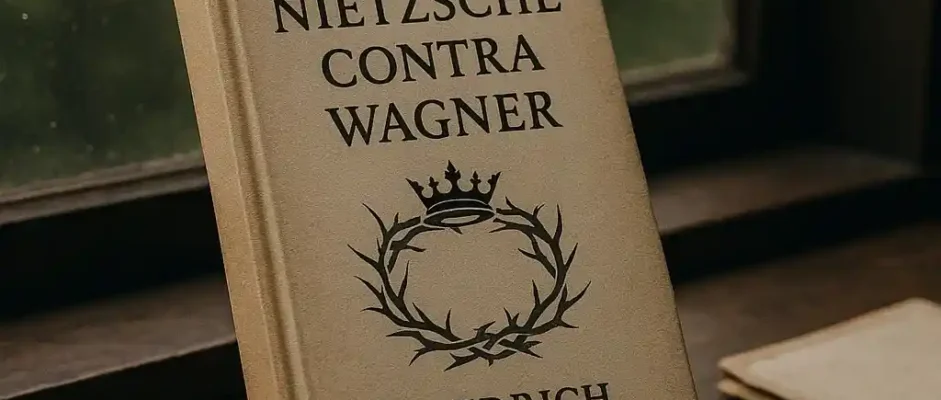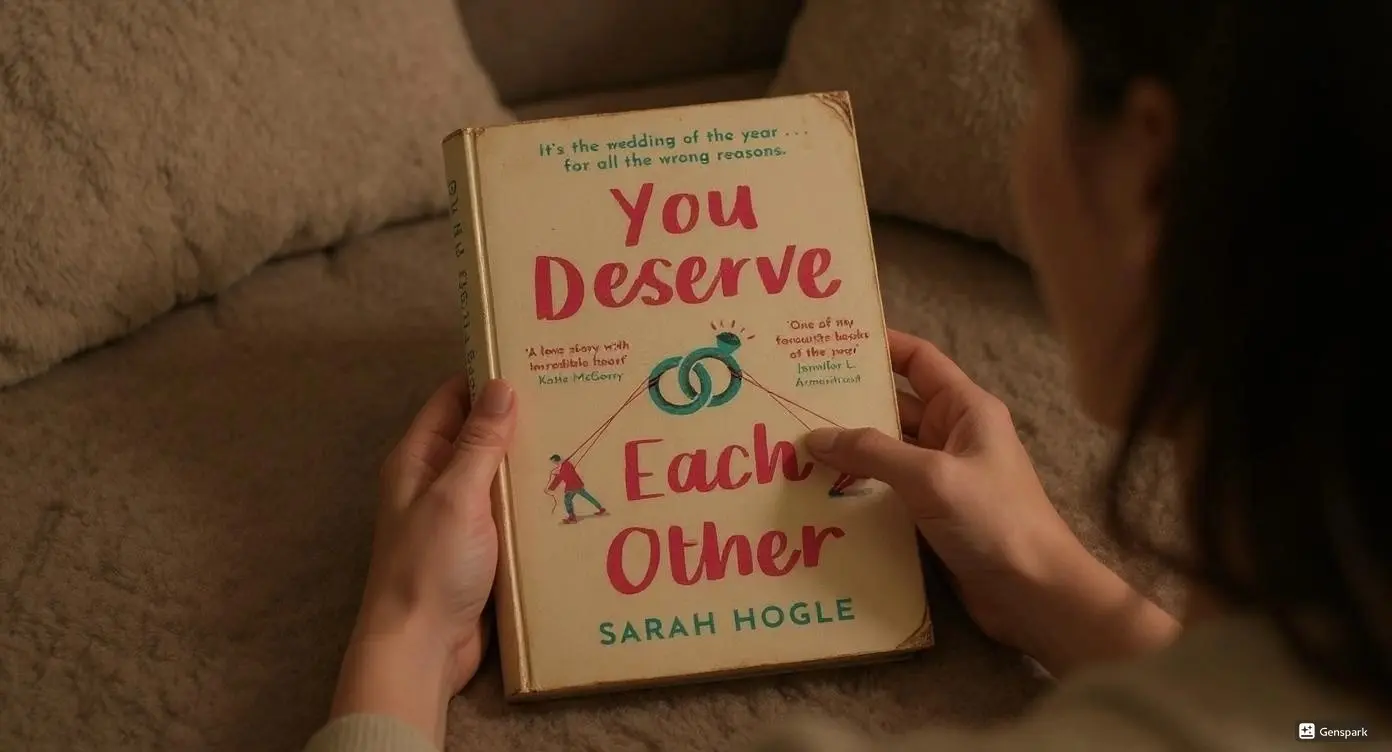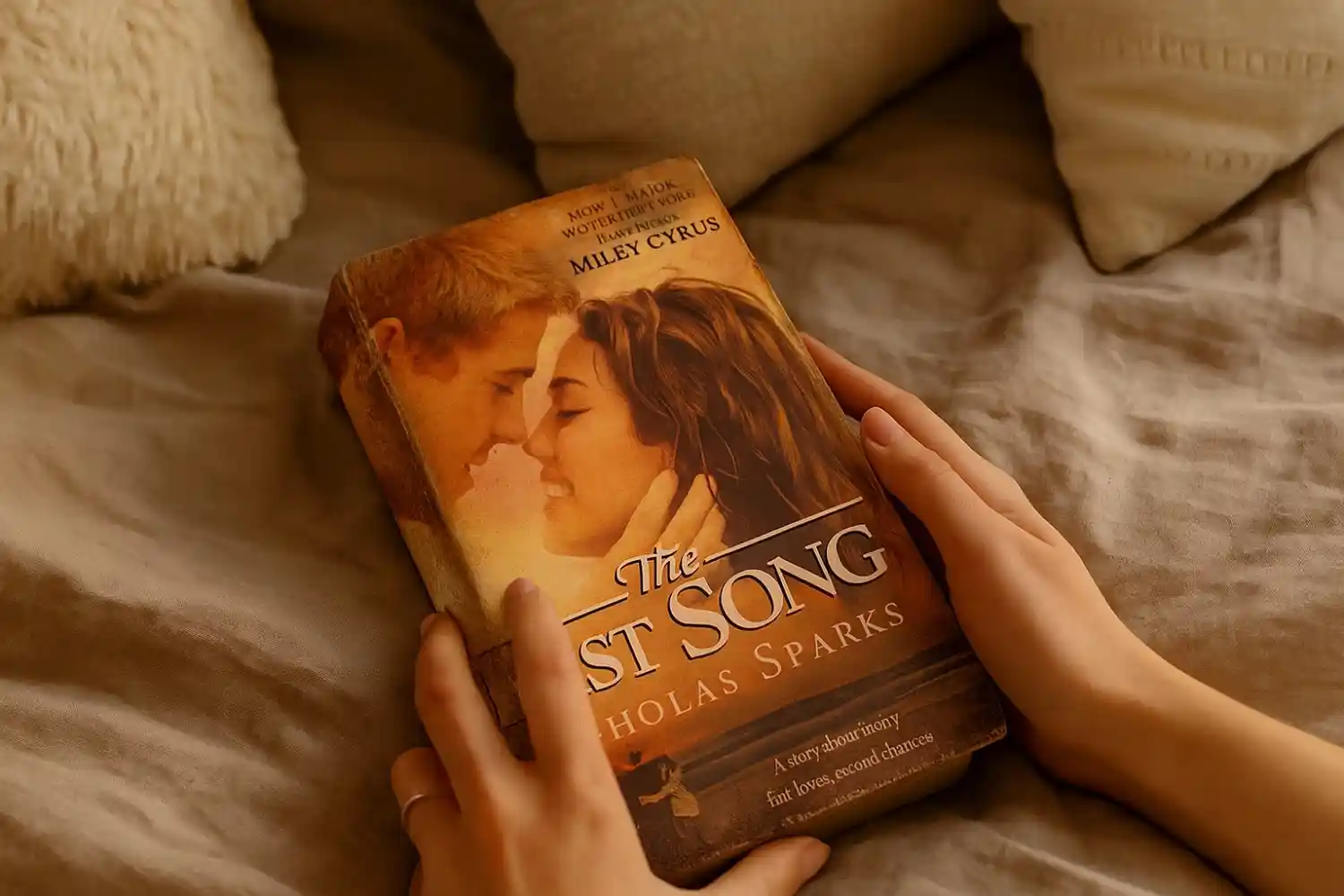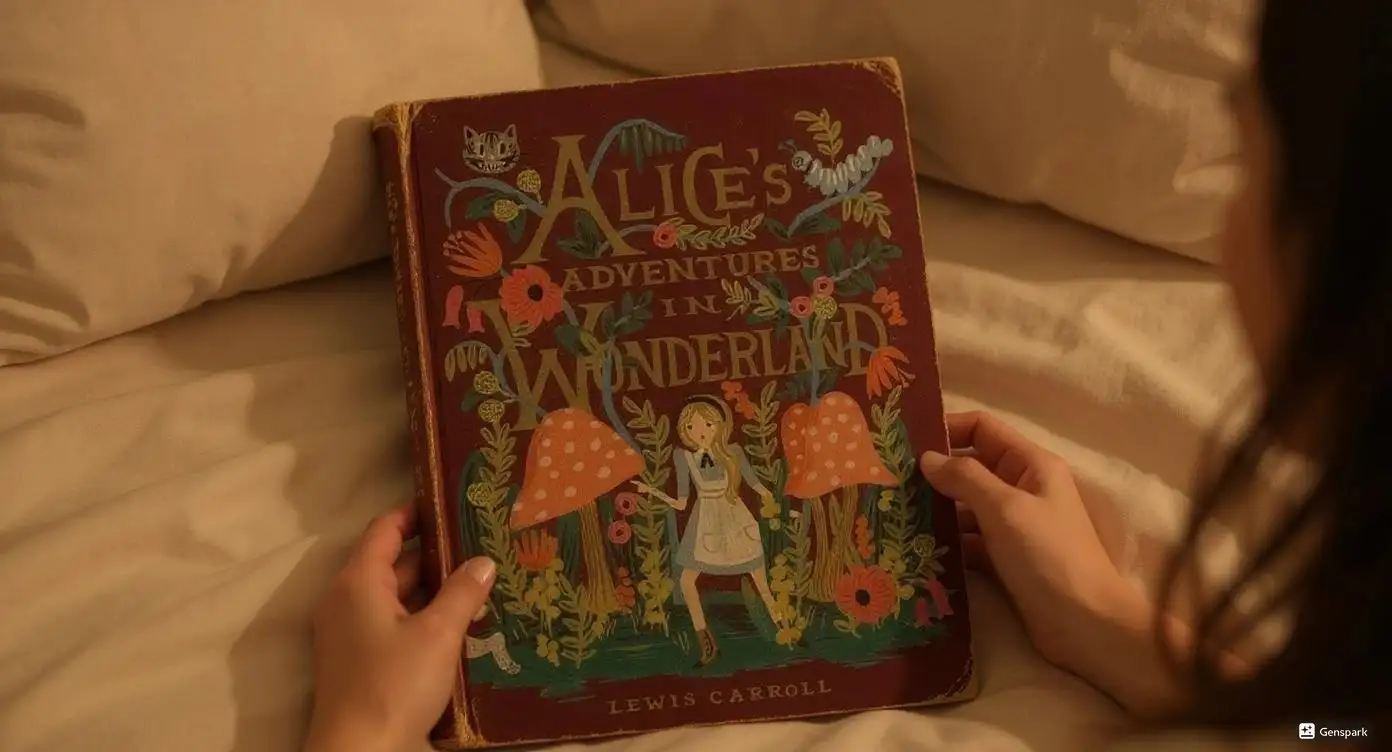Nietzsche Contra Wagner by Friedrich Nietzsche stands as one of philosophy’s most personal intellectual battles on his complex relationship with composer Richard Wagner. The book serves as both autobiography and philosophical manifesto, documenting the evolution from admiration to bitter opposition between two titans of German culture.
I picked up this book after wrestling with the contradictions in Nietzsche’s earlier praise of Wagner, curious about what sparked such a dramatic philosophical divorce. This collection of revised essays from Nietzsche’s previous works offers readers a front-row seat to one of history’s most famous intellectual feuds.
The book attracts philosophy students, music lovers, and anyone fascinated by the psychology of mentor-student relationships gone wrong. What makes this work special is its raw honesty – Nietzsche doesn’t just critique Wagner’s music but dissects the entire cultural movement Wagner represented.
The book’s greatest strength lies in Nietzsche’s surgical precision in separating artistic merit from personal disappointment, revealing how Wagner’s nationalism and anti-Semitism repulsed the cosmopolitan philosopher. However, readers may struggle with dense philosophical terminology and cultural references that assume deep knowledge of 19th-century German intellectual life. Nietzsche demonstrates how artistic admiration can transform into moral disgust when creators betray their own artistic principles.
Even though its challenging prose, this book offers profound insights into artistic integrity and the courage required to abandon former heroes. Reading it left me reconsidering my own intellectual influences and questioning whether loyalty to ideas should ever trump personal growth.
Key Takeaways
- Nietzsche Contra Wagner documents the dramatic intellectual transformation from devoted student to fierce critic, showcasing one of philosophy’s most famous mentor-disciple relationships gone wrong between two German cultural titans.
- The book serves as Nietzsche’s final philosophical statement on Wagner, compiled in 1888 during his last year of sanity by strategically rearranging excerpts from his earlier works to create a focused critique of the composer’s cultural influence.
- Nietzsche’s core criticism centers on Wagner’s shift from authentic artistic expression to theatrical manipulation, arguing that Wagner’s emphasis on dramatic spectacle and “infinite melody” compromises genuine musical integrity for mass appeal.
- The philosophical divide deepens over opposing worldviews: Nietzsche champions life-affirming art that embraces struggle and vitality, while Wagner’s later works (especially “Parsifal”) represent decadent escapism through religious consolation and emotional comfort.
- Nietzsche proposes a Mediterranean aesthetic alternative rooted in classical Greek values, viewing suffering as a transformative force for authentic creation rather than something to flee through artistic refuge.
- The work reveals Nietzsche’s mature aesthetic philosophy that judges art by its physiological effects, arguing that healthy art should stimulate vitality and challenge audiences rather than provide narcotic comfort to weakened modern individuals.
Publishing Information: 1889 by C. G. Naumann, Leipzig
Genre: Philosophical Criticism, Music Criticism
Series Information: Standalone essay, often published alongside “The Case of Wagner”
Page Count: Approximately 60–80 pages (varies by edition)
Main Characters / Figures:
- Friedrich Nietzsche: The author, philosopher, and former admirer of Wagner, who critically re-examines his relationship with Wagner and his music.
- Richard Wagner: German composer, once Nietzsche’s idol and friend, whose artistic and personal evolution Nietzsche scrutinizes.
Historical Context And Publication
The philosophical terrain between Nietzsche and Wagner shifted dramatically during the 1880s, marking one of literature’s most fascinating intellectual divorces. Knowing this book requires grasping the broader cultural moment when their relationship fractured.
Nietzsche’s Evolving Relationship With Wagner
Nietzsche’s transformation from devoted disciple to fierce critic unfolded across nearly two decades. In 1872, he dedicated “The Birth of Tragedy” to Wagner, viewing the composer as German culture’s savior. However, by the mid-1870s, cracks appeared in their friendship as Nietzsche witnessed Wagner’s increasing nationalism and anti-Semitism firsthand.
The philosopher’s disillusionment accelerated after attending the first Bayreuth Festival in 1876. What he expected to be a cultural renaissance instead struck him as theatrical excess and spiritual emptiness. By 1878, their personal relationship had effectively ended, though Nietzsche continued wrestling with Wagner’s influence throughout his remaining productive years.
Composition And Publication In Nietzsche’s Final Lucid Year
1888 marked both Nietzsche’s most prolific period and his final year of sanity. He completed “The Case of Wagner” in May, followed by “Nietzsche Contra Wagner” in December. Rather than writing entirely new material, Nietzsche strategically compiled excerpts from his earlier works, creating what amounts to a greatest hits collection of his Wagner criticism.
The timing proves significant – this represented Nietzsche’s last opportunity to settle accounts with his former mentor before mental collapse claimed him in January 1889. Published posthumously in February 1889, the book serves as both philosophical proof and personal reckoning with the most influential figure in his intellectual development.
Structure And Content Analysis
Reading through Nietzsche Contra Wagner feels like examining a carefully curated museum exhibit of philosophical thought. The book’s construction reveals Nietzsche’s methodical approach to documenting his intellectual evolution.
Thematic Organization Of The Nine Sections
The book divides into thematic segments that mirror Nietzsche’s psychological trip with Wagner. Each section builds upon his growing disillusionment while maintaining philosophical rigor.
I found the organization particularly effective because Nietzsche moves from admiration to criticism systematically. The sections explore Wagner’s emotional power while simultaneously dissecting his theatrical emphasis over pure musical artistry.
The thematic structure allows readers to trace Nietzsche’s evolving perspective chronologically. His admiration for Wagner’s ability to evoke emotion contrasts sharply with his later criticism of Wagner’s large-scale operatic works.
Compilation Method And Self-Citation
Nietzsche constructed this work by extracting passages from his earlier writings and rearranging them to focus specifically on Wagner. This anthology approach creates a concentrated examination of his Wagner-related thoughts spanning years.
The self-citation method proves both strength and weakness. While it provides comprehensive coverage of Nietzsche’s evolving views, it sometimes feels disjointed compared to his more unified works.
I appreciate how this compilation reveals the progression of Nietzsche’s thinking over time. The book serves as both autobiography and philosophical manifesto, showing how his relationship with Wagner shaped his broader cultural criticism.
Philosophical And Cultural Critique
Nietzsche’s critique of Wagner extends far beyond music into the fundamental nature of art’s relationship to cultural health. This philosophical treatise reveals Nietzsche’s mature aesthetic theory and his diagnosis of late 19th-century European decadence.
The Physiological Basis Of Nietzsche’s Aesthetic Judgment
Nietzsche’s aesthetic philosophy centers on the physiological effects of art on both creator and audience. He argues that healthy art emerges from strong, key creators and stimulates life-affirming responses in viewers.
Aesthetic judgment becomes a matter of biological health rather than abstract beauty. Nietzsche believes art should enhance vitality and affirm existence, challenging audiences to embrace life’s difficulties rather than providing escapist consolation.
Decadence And Cultural Decline In Wagnerian Art
Wagner’s music drama represents cultural exhaustion and neurosis in Nietzsche’s analysis. The composer’s excessive emotionality and theatrical grandeur signal the depletion of creative energies characteristic of declining civilizations.
Nietzsche views Wagner’s art as narcotic rather than stimulating, offering comfort to weakened modern individuals instead of challenging them to develop their will to power. The Bayreuth festival becomes a symbol of European cultural malaise rather than renewal.
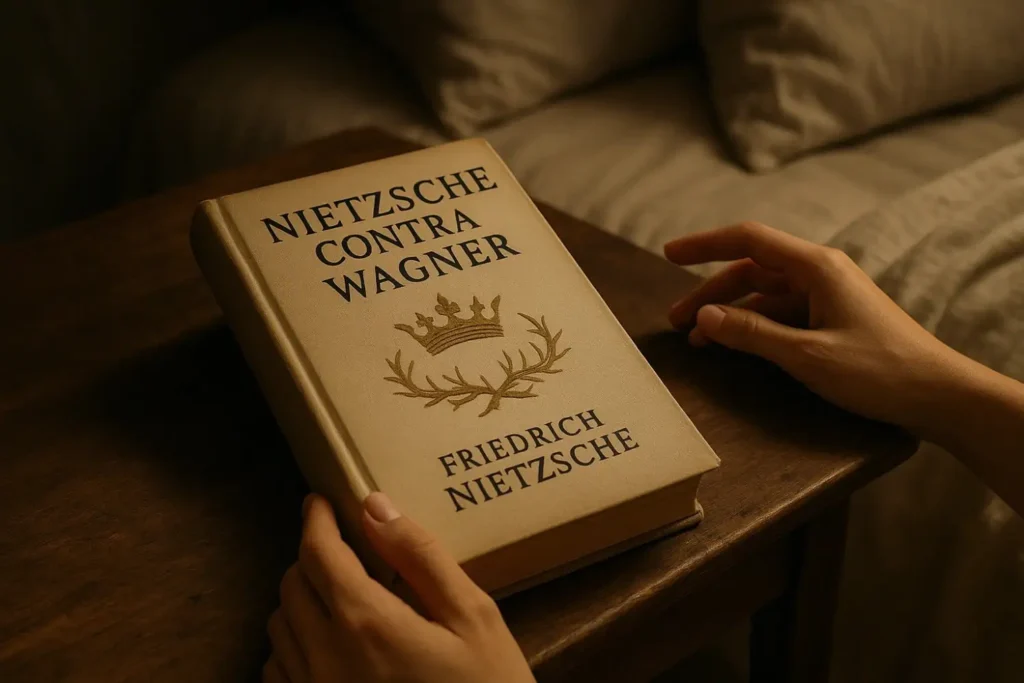
Musical And Artistic Analysis
Nietzsche’s examination of Wagner’s musical philosophy reveals deep tensions between emotional expression and artistic authenticity. His analysis dissects Wagner’s compositional techniques with the precision of a surgeon examining a patient.
Critique Of “Infinite Melody” And Rhythmic Degeneration
Nietzsche challenges Wagner’s concept of “infinite melody” as fundamentally flawed theatrical manipulation rather than genuine musical innovation. He argues this technique prioritizes dramatic effect over authentic musical expression, creating what he perceives as musical decadence. The philosopher criticizes Wagner’s rhythmic structure as lacking pleasing melody and coherent musical architecture, viewing it as symptomatic of broader cultural decline.
Wagner’s Theatricality Versus Authentic Musical Expression
Nietzsche perceives Wagner more as an actor than a composer, arguing his greatness stems from mass appeal rather than genuine artistic merit. He contends Wagner’s emphasis on theatricality compromises authentic musical expression, transforming music into spectacle.
This critique reflects Nietzsche’s belief that Wagner’s dramatic approach sacrifices musical integrity for emotional manipulation, prioritizing audience reaction over artistic truth.
Intellectual And Religious Dimensions
Nietzsche’s critique of Wagner extends far beyond musical preferences into the profound area of intellectual and religious philosophy. The philosophical battleground between these two German titans reveals fundamental disagreements about art’s purpose and humanity’s spiritual direction.
Wagner’s Christian Turn In Parsifal
Wagner’s final opera “Parsifal” became the focal point of Nietzsche’s most intense criticism. I found Nietzsche’s analysis particularly sharp when he describes Wagner’s supposed conversion to Christianity as a betrayal of artistic integrity.
Nietzsche viewed “Parsifal” as evidence of Wagner’s intellectual weakness and surrender to religious sentiment. The opera’s Christian symbolism and redemptive themes represented everything Nietzsche opposed about decadent European culture seeking comfort in faith.
The Philosophical Antipodes Of Life-Affirmation Versus Nihilism
The core philosophical divide between Nietzsche and Wagner centers on their opposing views of existence itself. Nietzsche championed life-affirmation and the will to power as needed human drives that create meaning through struggle.
Wagner’s later works embodied what Nietzsche saw as nihilistic tendencies – seeking escape from life’s challenges through religious consolation. This fundamental disagreement about whether art should energize or comfort audiences became central to Nietzsche’s critique of modern culture’s decline.
Nietzsche’s Alternative Vision
Nietzsche’s philosophical counterproposal to Wagner’s artistic worldview emerges as a radical reimagining of art’s role in human existence. Rather than seeking refuge from life’s challenges Wagner’s late works promised, Nietzsche advocates for a cultural philosophy that embraces struggle as the foundation of authentic creation.
Mediterranean Aesthetics And Life-Affirming Art
Nietzsche positions his aesthetic philosophy against Wagner’s Germanic romanticism by championing what he calls a Mediterranean sensibility rooted in classical Greek values. This alternative vision celebrates health, vitality, and the joyous affirmation of existence rather than seeking salvation through artistic experience.
The Mediterranean ideal that Nietzsche proposes treats art as an invigorating force that empowers life rather than as an escape mechanism. This approach demands that authentic artistic expression confront reality’s harsh truths while transforming them into sources of strength and philosophical insight.
Suffering As The Source Of Philosophical Depth
For Nietzsche, suffering represents not something to flee but the very condition that generates profound philosophical knowing and creative power. True art springs from this existential tension and struggle, making pain an needed ingredient in authentic artistic creation.
Wagner’s later works, particularly “Parsifal,” represent everything Nietzsche opposes by appealing to religious consolation and mass sentimentality instead of embracing suffering’s changing potential. Nietzsche argues that genuine artistic expression must avoid this spiritual weakness by treating suffering as a key, life-affirming force that art should embrace rather than suppress.
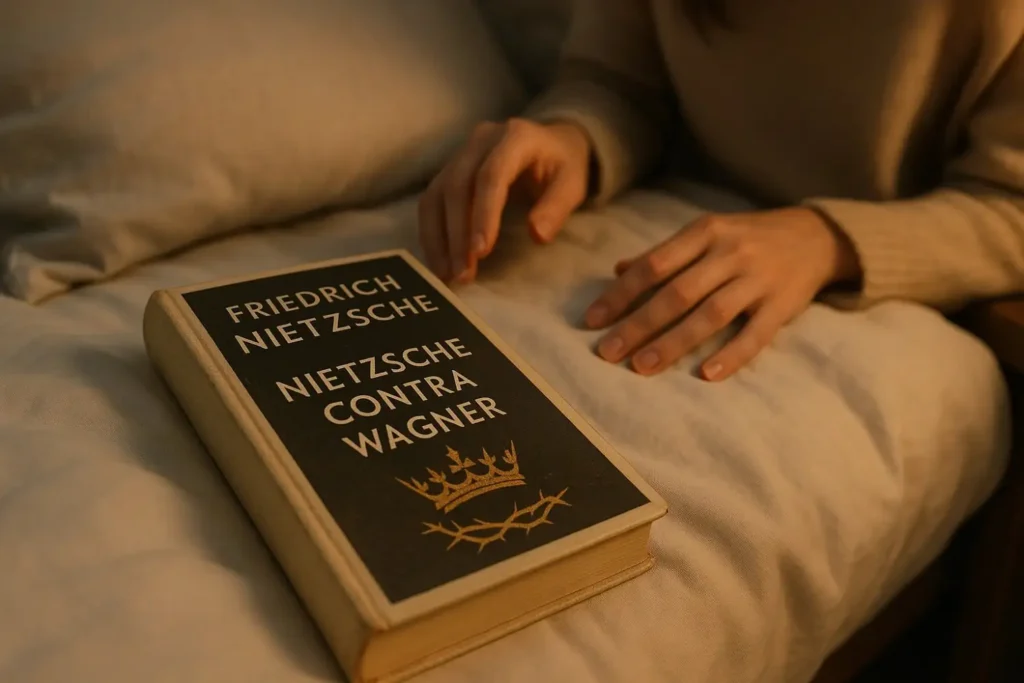
Final Verdict
Reading “Nietzsche Contra Wagner” felt like witnessing a master philosopher’s final reckoning with his greatest disappointment. This isn’t just a book review or philosophical treatise—it’s a deeply personal meditation on loyalty betrayal and intellectual growth.
What struck me most was how Nietzsche transformed his bitter disillusionment into something profoundly instructive. His critique of Wagner becomes a broader examination of what it means to create authentic art in a decadent age.
I’d recommend this book to anyone wrestling with their own intellectual heroes or questioning the cultural movements they once embraced. Nietzsche’s trip from admiration to opposition offers valuable lessons about maintaining artistic integrity even when it means abandoning comfortable illusions.
The book’s dense philosophical language demands patience but rewards careful readers with insights that extend far beyond 19th-century German culture into timeless questions about art truth and human vitality.
Dionysus Reviews Rating: 8.5/10
Sip The Unknown—Discover Stories You Never Knew You’d Love!
Dionysus Reviews Has A Book For Every Mood
Biography & Memoir
Fiction
Mystery & Detective
Nonfiction
Philosophy
Psychology
Romance
Science Fiction & Fantasy
Teens & Young Adult
Thriller & Suspense
Frequently Asked Questions
What is “Nietzsche Contra Wagner” about?
“Nietzsche Contra Wagner” is a philosophical treatise published posthumously in 1895 that explores Nietzsche’s dramatic shift from admiration to opposition toward composer Richard Wagner. The 95-page book serves as both autobiography and philosophical manifesto, detailing their deteriorating relationship and Nietzsche’s critique of Wagner’s nationalism, anti-Semitism, and what he saw as cultural decadence.
When was “Nietzsche Contra Wagner” written and published?
The book was compiled in 1888, Nietzsche’s most prolific year and his final year of sanity, before his mental collapse in January 1889. It was published posthumously in February 1889, making it one of Nietzsche’s last completed works before his psychological breakdown.
Why did Nietzsche turn against Wagner?
Nietzsche’s disillusionment began in the mid-1870s due to Wagner’s increasing nationalism and anti-Semitism. The breaking point came after attending the first Bayreuth Festival in 1876, where Nietzsche became deeply disappointed with Wagner’s ideals. Their personal relationship effectively ended by 1878, though Nietzsche continued grappling with Wagner’s influence throughout his life.
How is “Nietzsche Contra Wagner” structured?
The book is organized like a curated museum exhibit, compiled from excerpts of Nietzsche’s earlier works rather than entirely new content. It features nine thematic chapters that trace Nietzsche’s psychological journey from admiration to criticism, systematically moving through his evolving perspective on Wagner’s art and cultural influence.
What was Nietzsche’s main criticism of Wagner’s music?
Nietzsche criticized Wagner’s “infinite melody” as flawed manipulation that prioritized dramatic effect over genuine musical innovation. He viewed Wagner more as an actor than a composer, arguing that Wagner’s emphasis on theatricality compromised authentic musical expression and transformed music into spectacle rather than artistic truth.
Why did Nietzsche oppose Wagner’s “Parsifal”?
Nietzsche saw “Parsifal” as evidence of Wagner’s intellectual weakness and betrayal of artistic integrity through supposed conversion to Christianity. He viewed the opera as representing everything he opposed about decadent European culture seeking comfort in religious faith rather than confronting life’s harsh realities with strength and vitality.
What alternative vision did Nietzsche propose to Wagner’s art?
Nietzsche advocated for a Mediterranean sensibility rooted in classical Greek values that celebrates health, vitality, and joyous affirmation of existence. He believed art should be an invigorating force that empowers life, embracing struggle as the foundation of authentic creation rather than providing escapist consolation like Wagner’s later works.
Who should read “Nietzsche Contra Wagner”?
The book appeals to philosophy students, music lovers, and anyone interested in mentor-student dynamics or intellectual relationships. It offers valuable insights into artistic integrity, the complexities of intellectual loyalty, and prompts readers to reconsider their own influences and the balance between loyalty to ideas and personal growth.
